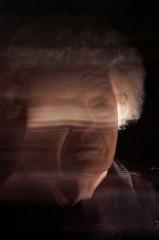Approximately every minute—67 seconds to be exact—someone in the US is diagnosed with Alzheimer’s disease. That’s about 1,440 people in a single day, and 525,600 people in a single year. The numbers speak for themselves. Alzheimer’s is a prevalent disease that needs a cure. But what can be done to combat an illness that has already affected millions of people worldwide? The answer may lie in ultrasound.
When most people hear the word “ultrasound,” their minds probably jump to black-and-white images of babies. Ultrasound is most commonly known as a procedure that pregnant women experience during regular check-ups. It is regarded as a safe procedure—so safe that most women don’t think twice before exposing it to their unborn children. Yet, Gerhard Leinenga and Jürgen Götz at the University of Queensland have found a novel and potentially more powerful use for ultrasound.
The main culprit believed to be involved in the development of Alzheimer’s disease is a protein fragment called beta-amyloid. These proteins can cluster to form plaques between neurons, regions termed “synapses.” Although the exact function of beta-amyloids in Alzheimer’s disease still remains unclear, scientific findings have suggested that the plaques block communication between neurons, causing neurons to die and thus contributing to the memory loss typical of Alzheimer’s patients.
Image Source: Science Photo Library – KTSDESIGN
Leinenga and Götz’s study, published recently in Science Translational Medicine, found that scanning ultrasound technique (SUS), in which an ultrasound beam repeatedly hits the entirety of a mouse’s brain, is able to destroy beta-amyloid plaques residing in synapses of Alzheimer’s-affected mice. SUS has the capability to temporarily open the blood-brain barrier and stimulate the activity of microglial cells that digest the plaques to free up synapses for neuronal communication.
Solely from SUS, 75% of mouse models in the study experienced full clearings of beta-amyloid plaques. The treated mice essentially had their memories “restored”—significantly improving their performances on memory tests compared to mice that did not undergo SUS. In fact, the mice treated with SUS performed at the same level as mice that possessed no tendencies towards Alzheimer’s.
Although other therapeutic strategies are in the works, none seem to fight against beta-amyloid plaques as well as SUS. Drugs and vaccines that produce antibodies against beta-amyloid production can come with costly side effects. While they may inhibit plaque build-up, they may also inhibit other mechanisms within the brain that are necessary for their functions. On the other hand, SUS is likely a safer approach. Studies of ultrasound on primates have shown no tissue damage, and researchers are hopeful to find the same conclusions in human trials.
From creating images of babies on screens to zapping away plaques, ultrasound has come a long way. A treatment for Alzheimer’s that has no medication or off-target side effects would be a major breakthrough in the fight against the numbers. 525,600 individuals can get diagnosed with Alzheimer’s each year, but it is quite possible that many will be able to say that they have overcome the disease.
Feature Image Source: Alzheimer’s by emmagarciamiller










